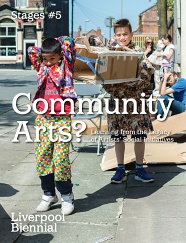
Five Takes on Collaborative Practice and Working with Artists, Non-artists and Institutions: Introduction
Anna Colin
Like everyone else contributing to this issue of Stages, I was asked to reflect on the Community Arts? Learning from the Legacy of Artists' Social Initiatives conference, and to keep the conversations that were started there going. What struck me most during this event was the deep divide between 1970s-80s Community Arts practice and present-day socially engaged practice, the resulting absence of a common vocabulary, some strong positions in defence of each 'camp' and occasional resentment. I invited five artists, organisers and curators of different generations to share their experiences, views and expertise on the topic. Ania Bas and Wendy Harpe were both present at the conference: Ania as a speaker and Wendy as a co-host and speaker. Ana Laura López de la Torre, Emily Pringle and Marijke Steedman weren't, but their positions and approaches have informed my own for varying lengths of time. Together they hopefully present a diversity of voices and a healthy dose of dissent.
I asked each of them to introduce their relationship to Community Arts, socially engaged and gallery education practice, and suggested discussing the following keywords: intent, subject (which perspective am I speaking from and whom am I addressing?), legitimacy (what is my own position within the community I am working with or representing, and how is it problematised? ), urgency (following a few claims in the audience that it is a prerequisite for Community Arts practice), and language. While most of these got touched on, new words cropped up with varying frequency: funding, validation, instrumentalisation, confrontation, responsibility, authorship, class, gender, race, generational divide, institutions and commissioners. In the transcribed conversations, the contributors provide a definition of the practice they identify with or have studied closely, and contextualise their position with lived experiences and concrete examples of practice. I take the opportunity to thank them for contributing their time and ideas.
As for my own position, in a nutshell, it is reflected both in the subjects I have chosen to attend to and in the selection of interlocutors: five inspiring women whom, for the most, I have had the privilege to work with. Like theirs, my practice is collaborative, inquisitive, political and feminist, and deeply invested in learning and the meeting of differences.
Anna Colin
Download this article as PDF
Anna Colin
Anna Colin is an independent curator based in London. She co-founded and co-directs Open School East, a space for collaborative learning in East London, which brings together a free study programme for artists and a multifaceted programme of events and activities programmed by and open to a broad range of voices. Anna also works as associate curator at Lafayette Anticipation: Fondation Galeries Lafayette in Paris, and is co-curator, with Lydia Yee, of the touring exhibition British Art Show 8 (2015-16).
- Introduction: Community Arts? Learning from the Legacy of Artists' Social Iniatives
Andrea Phillips - Pass the Parcel: Art, Agency, Culture and Community
Nina Edge - What is at Stake in Community Practice? What Have We Learned?
Jason E. Bowman - Navigating Community Arts and Social Practice: a Conversation about Tensions and Strategies
Laura Raicovich and Prerana Reddy - Lay Theatre and the Eruption of the Audience
Alan Read - Drawing Lines across History: Reactivation and Annotation
Ed Webb-Ingall - Five Takes on Collaborative Practice and Working with Artists, Non-artists and Institutions: Introduction
Anna Colin - Take One: "Affection, Protection, Direction”
Wendy Harpe - Take Two: "Between Community Arts and Socially Engaged Practice"
Ania Bas - Take Three: "From Community Practice to Gallery Education"
Emily Pringle - Take Four: "Beyond the Mural"
Marijke Steedman - Take Five: "Participate in What is Already Going On"
Ana Laura López de la Torre - Colophon